View in other NatureServe Network Field Guides
NatureServe
Montana
Utah
Wyoming
Idaho
Wisconsin
British Columbia
South Carolina
Yukon
California
New York
House Mouse - Mus musculus
Non-native Species
Global Rank:
G5
State Rank:
SNA
(see State Rank Reason below)
Agency Status
USFWS:
USFS:
BLM:
External Links
State Rank Reason (see State Rank above)
Species is nonnative/ introduced
General Description
The House Mouse, the most commonly found mouse near humans through history, is an average 6 1/2 inches long and 8/10 of an ounce in Montana (Foresman 2012). The large ears are nearly bare. The short fur will be grayish brown above, with an underside that will be brown, gray, or even whitish, but never pure white, as in other mice of the same size (Ulrich 1986). Unlike most voles and mice, the tail is nearly uniform in color, top and bottom, and is scaly rather than haired.
Species Range
Montana Range
Range Descriptions
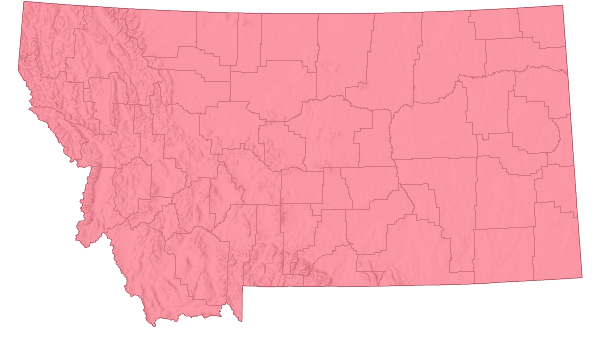
 Non-native
Non-native
Western Hemisphere Range
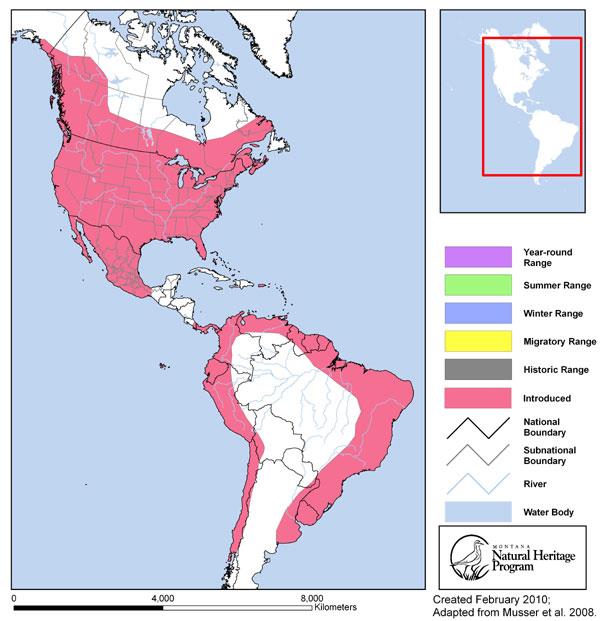
Observations in Montana Natural Heritage Program Database
Number of Observations: 187
(Click on the following maps and charts to see full sized version)
Map Help and Descriptions
Relative Density
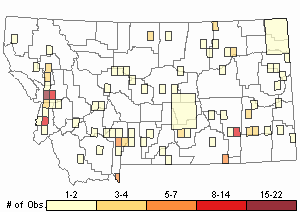
Recency

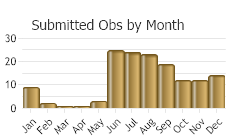
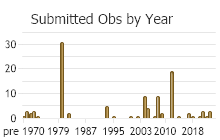
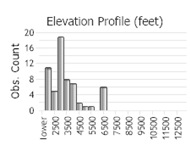 (Observations spanning multiple months or years are excluded from time charts)
(Observations spanning multiple months or years are excluded from time charts)
Habitat
Human habitation, agricultural developments. Grassy meadows, and marsh areas (Lampe et al. 1974) along railroads and fence rows (Dood 1980). May live in feral communities (Banfield 1974).
Ecology
Social. Builds nests of grasses. Though mostly terrestrial, will make burrows. Will use microtine runways. (Banfield 1974).
References
- Literature Cited AboveLegend:
 View Online Publication
View Online Publication Banfield, A.W.F. 1974. The mammals of Canada. University of Toronto Press for National Museum of Natural Science and the National Museums of Canada, 438 pp.
Banfield, A.W.F. 1974. The mammals of Canada. University of Toronto Press for National Museum of Natural Science and the National Museums of Canada, 438 pp. Dood, A.R. 1980. Terry Badlands nongame survey and inventory final report. Montana Department of Fish, Wildlife, and Parks and Bureau of Land Management, Helena, MT. 70 pp.
Dood, A.R. 1980. Terry Badlands nongame survey and inventory final report. Montana Department of Fish, Wildlife, and Parks and Bureau of Land Management, Helena, MT. 70 pp. Lampe, R.P., J.K. Jones Jr., R.S. Hoffmann, and E.C. Birney. 1974. The mammals of Carter County, southeastern Montana. Occa. Pap. Mus. Nat. Hist. Univ. Kan. 25:1-39.
Lampe, R.P., J.K. Jones Jr., R.S. Hoffmann, and E.C. Birney. 1974. The mammals of Carter County, southeastern Montana. Occa. Pap. Mus. Nat. Hist. Univ. Kan. 25:1-39. Ulrich, T.J. 1986, Mammals of the northern Rockies
Ulrich, T.J. 1986, Mammals of the northern Rockies
- Additional ReferencesLegend:
 View Online Publication
View Online Publication
Do you know of a citation we're missing? Anaconda Minerals Company, and Camp, Dresser & McKee. 1981. Anaconda Stillwater Project 6-month environmental baseline report. CDM Project No. 3139. Vol. I Appendix. Jan. 15, 1981.
Anaconda Minerals Company, and Camp, Dresser & McKee. 1981. Anaconda Stillwater Project 6-month environmental baseline report. CDM Project No. 3139. Vol. I Appendix. Jan. 15, 1981. Bauer, Delane, 2002, 2002 Four Seasons Wildlife Study. Savage Mine Report, Richland County, Montana.
Bauer, Delane, 2002, 2002 Four Seasons Wildlife Study. Savage Mine Report, Richland County, Montana. Bowdoin NWR. 2000. A survey of the small, terrestrial mammals at Bowdoin NWR: Malta, Montana.
Bowdoin NWR. 2000. A survey of the small, terrestrial mammals at Bowdoin NWR: Malta, Montana. Bramblett, R.G., and A.V. Zale. 2002. Montana Prairie Riparian Native Species Report. Montana Cooperative Fishery Research Unit, Montana State University - Bozeman.
Bramblett, R.G., and A.V. Zale. 2002. Montana Prairie Riparian Native Species Report. Montana Cooperative Fishery Research Unit, Montana State University - Bozeman. Buck, C.L. 1939. Pattern correlation of mammalian teeth as a means of identification. M.Sc. Thesis. Bozeman, Montana: Montana State University. 55 p.
Buck, C.L. 1939. Pattern correlation of mammalian teeth as a means of identification. M.Sc. Thesis. Bozeman, Montana: Montana State University. 55 p. Carlsen, T. and R. Northrup. 1992. Canyon Ferry Wildlife Management Area Final Draft Management Plan. March 1992.
Carlsen, T. and R. Northrup. 1992. Canyon Ferry Wildlife Management Area Final Draft Management Plan. March 1992. Foresman, K.R. 2001. The wild mammals of Montana. American Society of Mammalogists, Special Publication Number 12. Lawrence, KS. 278 pp.
Foresman, K.R. 2001. The wild mammals of Montana. American Society of Mammalogists, Special Publication Number 12. Lawrence, KS. 278 pp. Foresman, K.R. 2012. Mammals of Montana. Second edition. Mountain Press Publishing, Missoula, Montana. 429 pp.
Foresman, K.R. 2012. Mammals of Montana. Second edition. Mountain Press Publishing, Missoula, Montana. 429 pp. Hanauska-Brown, L., B.A. Maxell, A. Petersen, and S. Story. 2014. Diversity Monitoring in Montana 2008-2010 Final Report. Montana Fish, Wildlife & Parks. Helena, MT. 78 pp.
Hanauska-Brown, L., B.A. Maxell, A. Petersen, and S. Story. 2014. Diversity Monitoring in Montana 2008-2010 Final Report. Montana Fish, Wildlife & Parks. Helena, MT. 78 pp. Heath, M.L. 1973. Small mammal populations in clearcuts of various ages in south central Montana. M.Sc. Thesis. Bozeman, Montana: Montana State University. 33 p.
Heath, M.L. 1973. Small mammal populations in clearcuts of various ages in south central Montana. M.Sc. Thesis. Bozeman, Montana: Montana State University. 33 p. Hodgson, J.R. 1970. Ecological distribution of Microtus montanus and Microtus pennsylvanicus in an area of geographic sympatry in southwestern Montana. Ph.D. Dissertation. Bozeman, Montana: Montana State University. 65 p.
Hodgson, J.R. 1970. Ecological distribution of Microtus montanus and Microtus pennsylvanicus in an area of geographic sympatry in southwestern Montana. Ph.D. Dissertation. Bozeman, Montana: Montana State University. 65 p. Hoffmann, R.S. and D.L. Pattie. 1968. A guide to Montana mammals: identification, habitat, distribution, and abundance. Missoula, MT: University of Montana. 133 p.
Hoffmann, R.S. and D.L. Pattie. 1968. A guide to Montana mammals: identification, habitat, distribution, and abundance. Missoula, MT: University of Montana. 133 p. Joslin, Gayle, and Heidi B. Youmans. 1999. Effects of recreation on Rocky Mountain wildlife: a review for Montana. [Montana]: Montana Chapter of the Wildlife Society.
Joslin, Gayle, and Heidi B. Youmans. 1999. Effects of recreation on Rocky Mountain wildlife: a review for Montana. [Montana]: Montana Chapter of the Wildlife Society. Koplin, J.R. 1962. Competition and niche segregation in the genus Microtus. M.S. thesis. Montana State University. 66 pp.
Koplin, J.R. 1962. Competition and niche segregation in the genus Microtus. M.S. thesis. Montana State University. 66 pp. Kritzman, E.B. 1977. Little mammals of the Pacific Northwest. Pacific Search Press, Seattle, WA.
Kritzman, E.B. 1977. Little mammals of the Pacific Northwest. Pacific Search Press, Seattle, WA. Martin, P.R., K. Dubois and H.B. Youmans. 1981. Terrestrial wildlife inventory in selected coal areas, Powder River resources area final report. Montana Department of Fish, Wildlife and Parks and Bureau of Land Management, Helena, MT. No. YA-553-CTO- 24. 288 p.
Martin, P.R., K. Dubois and H.B. Youmans. 1981. Terrestrial wildlife inventory in selected coal areas, Powder River resources area final report. Montana Department of Fish, Wildlife and Parks and Bureau of Land Management, Helena, MT. No. YA-553-CTO- 24. 288 p. Pefaur, J. E., and R. S. Hoffmann. 1975. Studies of small mammal populations at three sites on the Northern Great Plains. Occasional Papers of the Museum of Natural History, University of Kansas, Lawrence. No. 37:1-27.
Pefaur, J. E., and R. S. Hoffmann. 1975. Studies of small mammal populations at three sites on the Northern Great Plains. Occasional Papers of the Museum of Natural History, University of Kansas, Lawrence. No. 37:1-27. Powder River Eagle Studies, Inc., Gillette, WY., 1994?, Big Sky Mine 1993 wildlife studies. Date???
Powder River Eagle Studies, Inc., Gillette, WY., 1994?, Big Sky Mine 1993 wildlife studies. Date??? Reichel, J.D. and S.G. Beckstrom. 1994. Northern bog lemming survey: 1993. Unpublished report. Montana Natural Heritage Program. Helena, MT. 87 pp.
Reichel, J.D. and S.G. Beckstrom. 1994. Northern bog lemming survey: 1993. Unpublished report. Montana Natural Heritage Program. Helena, MT. 87 pp. Reid, F. 2006. Peterson Field Guide to Mammals of North America, 4th Edition. Houghton Mifflin Company: Boston and New York, 608 pp.
Reid, F. 2006. Peterson Field Guide to Mammals of North America, 4th Edition. Houghton Mifflin Company: Boston and New York, 608 pp. Rust, H. J. 1946. Mammals of northern Idaho. J. Mammal. 27(4): 308-327.
Rust, H. J. 1946. Mammals of northern Idaho. J. Mammal. 27(4): 308-327. Sawyer, H. E. 1935. Studies on the rodents of Montana. M.A. thesis. University of Montana, Missoula. 111 pp.
Sawyer, H. E. 1935. Studies on the rodents of Montana. M.A. thesis. University of Montana, Missoula. 111 pp. Schladweiler, Philip, and John P. Weigand., 1983, Relationships of endrin and other chlorinated hydrocarbon compounds to wildlife in Montana, 1981-1982. September 1983.
Schladweiler, Philip, and John P. Weigand., 1983, Relationships of endrin and other chlorinated hydrocarbon compounds to wildlife in Montana, 1981-1982. September 1983. Scow, K.L. 1981. Ecological distribution of small mammals at Sarpy Creek, Montana, with special consideration of the Deer Mouse, Peromyscus maniculatus. M.Sc. Thesis. Bozeman, Montana: Montana State University. 73 p.
Scow, K.L. 1981. Ecological distribution of small mammals at Sarpy Creek, Montana, with special consideration of the Deer Mouse, Peromyscus maniculatus. M.Sc. Thesis. Bozeman, Montana: Montana State University. 73 p. Tschache, O.P. 1970. Effects of ecological changes induced by various sagebrush control techniques on small mammal populations. M.Sc. Thesis. Bozeman, MT: Montana State University. 51 p.
Tschache, O.P. 1970. Effects of ecological changes induced by various sagebrush control techniques on small mammal populations. M.Sc. Thesis. Bozeman, MT: Montana State University. 51 p. Waage, B.C. 1984. Western Energy Company Rosebud Mine, Rosebud County, Montana: Annual Wildlife Monitoring Report, 1983 Field Season. June 1984.
Waage, B.C. 1984. Western Energy Company Rosebud Mine, Rosebud County, Montana: Annual Wildlife Monitoring Report, 1983 Field Season. June 1984. Waage, B.C. 1986. Western Energy Company Rosebud Mine, Rosebud County, Montana: Annual Wildlife Monitoring Report, 1985 Field Season. December 1985.
Waage, B.C. 1986. Western Energy Company Rosebud Mine, Rosebud County, Montana: Annual Wildlife Monitoring Report, 1985 Field Season. December 1985. Waage, B.C. 1988. Western Energy Company Rosebud Mine, Colstrip, Montana: Annual Wildlife Monitoring Report, 1988 Field Season. December 1988.
Waage, B.C. 1988. Western Energy Company Rosebud Mine, Colstrip, Montana: Annual Wildlife Monitoring Report, 1988 Field Season. December 1988. Waage, Bruce C., 1993, Western Energy Company Rosebud Mine, Colstrip, Montana: Annual Wildlife Monitoring Report; 1992 Field Season. December 1993.
Waage, Bruce C., 1993, Western Energy Company Rosebud Mine, Colstrip, Montana: Annual Wildlife Monitoring Report; 1992 Field Season. December 1993. Waage, Bruce C., 1996, Western Energy Company Rosebud Mine, Colstrip, Montana: 1995 Annual Wildlife Monitoring Report; December 1, 1994 - November 30, 1995. February 28, 1996.
Waage, Bruce C., 1996, Western Energy Company Rosebud Mine, Colstrip, Montana: 1995 Annual Wildlife Monitoring Report; December 1, 1994 - November 30, 1995. February 28, 1996. Waage, Bruce C., 1999, Western Energy Company Rosebud Mine, Colstrip, Montana: 1998 Annual Wildlife Monitoring Report; December 1, 1997 - November 30, 1998 Survey Period. February 24, 1999.
Waage, Bruce C., 1999, Western Energy Company Rosebud Mine, Colstrip, Montana: 1998 Annual Wildlife Monitoring Report; December 1, 1997 - November 30, 1998 Survey Period. February 24, 1999. Western Energy Co., Colstrip, MT., 1981, Western Energy Company Rosebud Mine, Colstrip, Montana: Annual Wildlife Report, 1981.
Western Energy Co., Colstrip, MT., 1981, Western Energy Company Rosebud Mine, Colstrip, Montana: Annual Wildlife Report, 1981. Westmoreland Resources, Inc., Hardin, MT., 1981, Upper Sarpy Basin Wildlife Study. In 1981 Wildlife Report. April 1982.
Westmoreland Resources, Inc., Hardin, MT., 1981, Upper Sarpy Basin Wildlife Study. In 1981 Wildlife Report. April 1982.
- Web Search Engines for Articles on "House Mouse"
- Additional Sources of Information Related to "Mammals"





